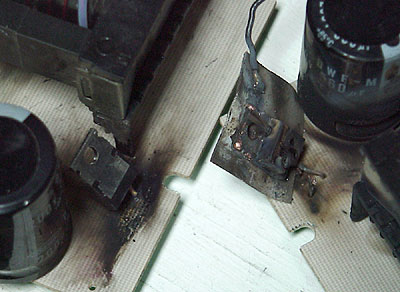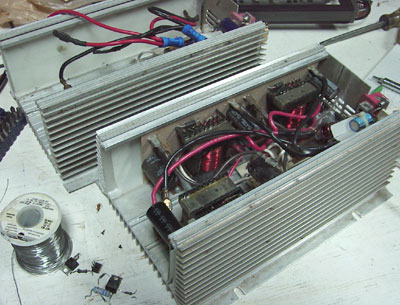Explode-O-Matic Todd Charger
I mentioned at the end of the Lester thread that the charger for my Electrak tractor had turned itself into an improvised incendiary device, leaving me with fewer options for charging the tractor's battery pack.
Today was a wet and blustery one, so I stayed indoors and began the operation of repairing the Todd charger. Once I had it open, the sight was not a pretty one:

This is a high frequency switching supply with three modules, one master and two slaves. The input of the modules is rectified line voltage, about 164 volts DC. The output of each module is 12 volts nominal, three modules wired in series for 36 volts to charge the tractor.
Problem is that one little stressed component can cause the master module to fry dramatically, setting up a chain reaction that takes out the slaves in a spectacular display of fireworks. This charger had caught fire once before, but not nearly as badly. This time, I was faced with some heavy duty rebuilding. The burned components you see are the tip of the iceberg, there is much more damage to smaller components on the underside of the high frequency transformers, burned resistors, diodes, integrated circuits, etc.
Fortunately, I am a resourceful pack rat, and had a spare charger on the shelf out in the storage locker:

It was something that someone had given me back when I was still repairing these things for money. I plugged it in one time to test it, but got nothing for my efforts. Turns out that it needed only two resistors replaced, all of the active components were OK. This made my job much easier, if I don't have to replace IC's and MOSFET's, I don't have to recalibrate and align the PWM section to keep the current at a safe level.
What I ended up doing was swapping over the modules from the spare charger to the old heat sink assembly. The spare charger had some corrosion on the underside of the heat sink that had seized the steel screws tapped into it, I ended up breaking off the heads of all of them on one side of the charger. No matter, I had enough parts to make one functional charger with a bag of mostly burned stuff left over for "next time".
Todd chargers are the most bare-bones switching supplies you could imagine. The master module uses a single PWM regulator IC that has minimal input protection. There is a current sense shunt in the master MOSFET circuit, and a rudimentary voltage sense with optical isolation. None of the slave modules have any smarts at all, they just switch when the master says "jump". If there is a leakage or short in the master MOSFET, all the modules get the "full-on" signal and self-destruct. There are some bootstrap pull-up resistors from the DC buss to get the PWM chip started, then the control circuit runs from flyback voltage generated by the output transformer. Any disturbances in the input tends to throw the control circuit into fits and then the smoke starts. Low input voltage will kill these chargers every time! Fuses? This is a fuse-free design product.
Normally, the modules are in parallel for 12 volt output. I have a couple of these chargers that have four slave modules for an output of 12 volts at 75 amperes. They are even more impressive when they go off like a string of firecrackers! The two-slave chargers were meant to be 45 ampere 12 volt chargers. I don't think that running the outputs in series has any effect on the reliability, the master module still only sees 12 volts at 15 amperes.
I've thought about making them more sophisticated, but that would mean starting from scratch, which is more trouble then I have the time for. These chargers were cheap to purchase when new. They were also sold by Heliotrope for a time as well as Todd. There were successors once Todd stopped production, supplies that used more protection circuitry and more sophisticated drive designs. I'm thinking about True chargers, etc.
I know people who have been using the same Todd for years without problems. Of course, most all of my chargers were built from scrapped units that I acquired after they had suffered their first (or second, etc) blowout. I used to use one with a 130 volt DC input from my solar array to charge the batteries on the system. Eliminated a lot of loss in the long run of wiring from out in the yard.
As long as I have a pile of spare parts in the shed I'll probably just keep rebuilding them. It's not like I depend on them for life support or anything.
Original material ©1996-2025 Mr. Sharkey | All rights reserved
